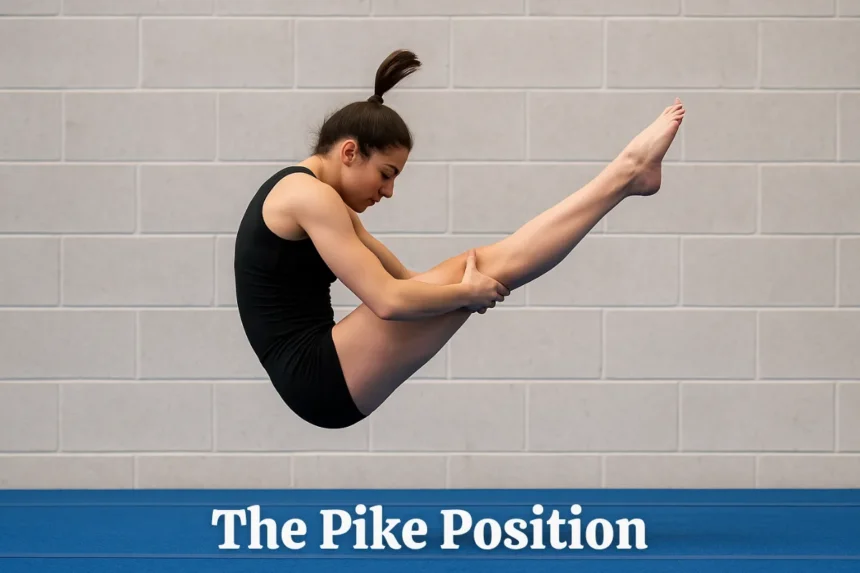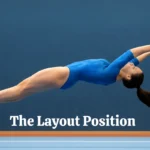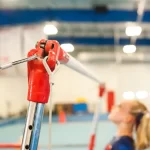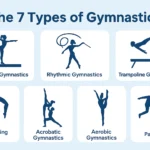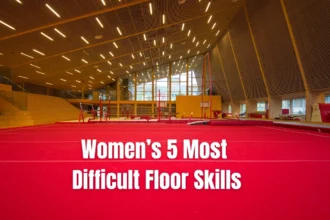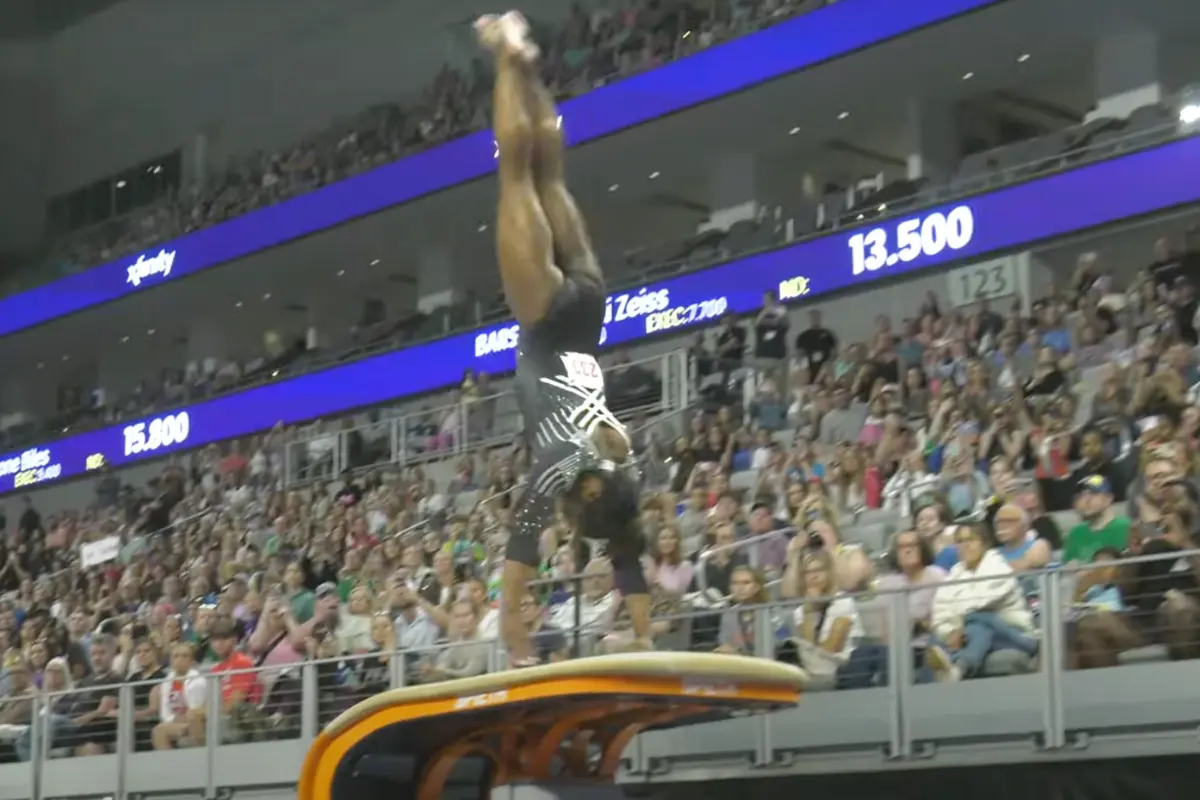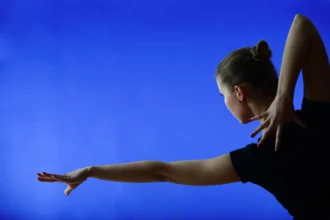Few shapes in gymnastics are as instantly recognizable—or as deceptively difficult—as the pike. With folded hips, razor-straight legs, and toes pointed to the horizon, the gymnast forms a living capital “V.”
Mastering the pike unlocks a powerful toolkit—vaults, saltos, and bar releases—that blend clean lines with explosive lift.
1. Defining the Pike
At its simplest, a pike is any body position in which the hips flex roughly 90 degrees (or tighter), the knees remain fully extended, and the spine stays neutral to slightly rounded. Think “folded like a beach chair, but polished like a ballerina.”
Unlike a tuck—where the thighs chase the chest—or a layout—where the body stays long—the pike occupies a middle ground: it trims rotational inertia without sacrificing the clean line judges crave.
Key checkpoints
- Hip angle: ≤ 90° is ideal; anything wider risks deductions for an “open pike.”
- Knee angle: locked straight, no daylight behind the knees.
- Spine: subtle C-curve, never arched.
- Foot line: toes pointed so the calf and instep read as a single, unbroken blade.
Why the Pike Position Is Important
From beginner classes to the Olympic stage, the pike is more than just a pretty shape. It’s a powerful tool that helps gymnasts improve control, build strength, stay safe, and look polished. Learning it early sets the stage for harder skills down the road.
1. It Balances Speed and Style
Tuck flips spin fast but look small and tight. Layouts look clean and stretched but need more height and power. The pike shape gives you a bit of both—it spins faster than a layout but still looks long and controlled.
That’s why gymnasts use it in big skills like double pikes, piked Jaegers, and Yurchenko pike vaults. It’s fast, strong, and beautiful.
2. It Helps You Level Up
In gymnastics, most skills progress from tuck → pike → layout. Once you can hold a strong pike in the air, moving into layouts or adding twists is easier. Skipping over the pike usually causes problems later—especially with body control and timing.
3. It Builds Core Strength
The pike shape works your abs, hips, and legs simultaneously. Holding straight legs while folding at the hips teaches your body how to stay tight and strong in the air. This kind of strength helps in everything from cast handstands to bar swings to round-offs.
4. It Makes Landings Safer
Because pike flips rotate faster than layouts, they often finish earlier—giving gymnasts more time to open up and land with a tall chest. That helps reduce pressure on the knees, ankles, and lower back, which means fewer injuries.
5. It Scores Well in Competition
Judges look for:
- Straight legs
- Pointed toes
- Clean shapes
A well-done pike usually gets better scores than a rushed tuck and avoids the “not enough stretch” deductions that layouts sometimes get.
6. It’s Easy to Spot and Fix
The pike shape is clear: straight legs and a 90° hip angle. Coaches can see it from the sidelines, and gymnasts can feel it in the air. That makes it easy to correct and improves learning.
Where You’ll Meet the Pike in Competition
The pike position shows up in every gymnastics event—sometimes in basic skills, other times in some of the hardest moves in the sport. Whether it’s a salto, release, or vault, gymnasts use the pike shape to get speed, style, and better scores.
Here’s where you’ll commonly see it, along with how difficult each skill is based on the current FIG Code of Points (2025–2028):
| Apparatus | Signature Pike Skills | Typical Difficulty |
|---|---|---|
| Floor | – Single pike salto forward or backward (A) – Double back pike (D) – Double Arabian pike (E) | A – E |
| Beam | – Gainer full-in pike dismount (F) – Front pike step-out (C) | C – F |
| Vault | – Handspring front pike (D) – Yurchenko pike half-on (C) – Biles I – Yurchenko double pike (J) | C – J |
| Uneven Bars | – Piked Jaeger (E) – Piked Pak salto (D) | D – E |
📝 Note: These values follow the 2025–2028 FIG Women’s Artistic Gymnastics Code of Points. The higher the letter, the more difficult the skill.
How Judges See It: Scoring Nuances
- Leg separation – even a thumb-width gap can cost 0.10.
- Knees softening on the snap-down? Expect 0.30.
- Hip angle drift > 90° mid-flight draws up to 0.50.
- Line on landing – chest too low betrays insufficient block or an early open.
In short, the pike’s promise—crisper lines—also exposes every lapse in form.
From Pike to Layout: The Next Progression
Once a gymnast can perform a clean, tight pike in the air, the next big milestone is the layout. At first glance, it might seem like just a harder version of the pike—but it’s a different challenge altogether. The layout requires more height, more strength, and far more control.
What Is the Layout Position?
In a layout, the body stays completely straight throughout the entire flip. That means:
- Legs are straight and pressed together
- Hips are fully open (no bend at the waist)
- Arms are either overhead or close to the sides
- Core stays tight to prevent arching or wobbling
- Toes are pointed, forming one long line from fingers to feet
It’s all about creating a clean, stretched shape—and holding it steady while flipping through the air.
Why It’s Harder Than Pike
When a gymnast moves from pike to layout, rotation slows down. That’s because in the layout, the body is longer and less compact, increasing its moment of inertia (resistance to spinning).
To make it work, the gymnast has to:
- Jump higher to give more time for rotation
- Stay tight even without bending at the hips
- Time the shape change precisely at takeoff
There’s no folding to help speed things up—just one long, rigid shape flipping through the air. That’s why layouts usually come only after the gymnast has mastered strong takeoffs and solid midair control.
